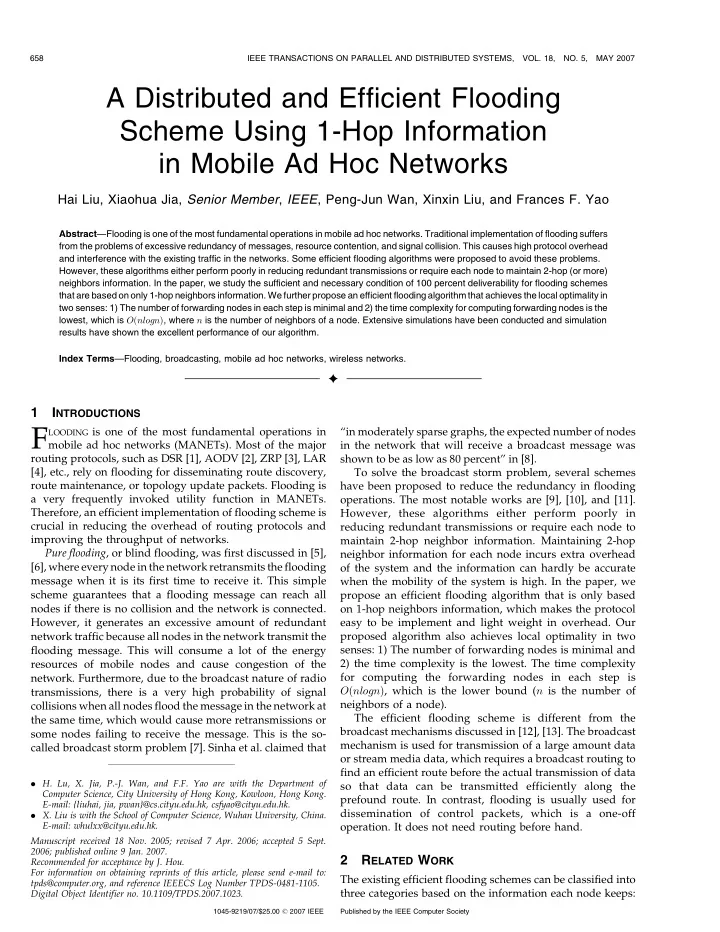

658 IEEE TRANSACTIONS ON PARALLEL AND DISTRIBUTED SYSTEMS, VOL. 18, NO. 5, MAY 2007 A Distributed and Efficient Flooding Scheme Using 1-Hop Information in Mobile Ad Hoc Networks Hai Liu, Xiaohua Jia, Senior Member , IEEE , Peng-Jun Wan, Xinxin Liu, and Frances F. Yao Abstract —Flooding is one of the most fundamental operations in mobile ad hoc networks. Traditional implementation of flooding suffers from the problems of excessive redundancy of messages, resource contention, and signal collision. This causes high protocol overhead and interference with the existing traffic in the networks. Some efficient flooding algorithms were proposed to avoid these problems. However, these algorithms either perform poorly in reducing redundant transmissions or require each node to maintain 2-hop (or more) neighbors information. In the paper, we study the sufficient and necessary condition of 100 percent deliverability for flooding schemes that are based on only 1-hop neighbors information. We further propose an efficient flooding algorithm that achieves the local optimality in two senses: 1) The number of forwarding nodes in each step is minimal and 2) the time complexity for computing forwarding nodes is the lowest, which is O ð nlogn Þ , where n is the number of neighbors of a node. Extensive simulations have been conducted and simulation results have shown the excellent performance of our algorithm. Index Terms —Flooding, broadcasting, mobile ad hoc networks, wireless networks. Ç 1 I NTRODUCTIONS F LOODING is one of the most fundamental operations in “in moderately sparse graphs, the expected number of nodes mobile ad hoc networks (MANETs). Most of the major in the network that will receive a broadcast message was routing protocols, such as DSR [1], AODV [2], ZRP [3], LAR shown to be as low as 80 percent” in [8]. [4], etc., rely on flooding for disseminating route discovery, To solve the broadcast storm problem, several schemes route maintenance, or topology update packets. Flooding is have been proposed to reduce the redundancy in flooding a very frequently invoked utility function in MANETs. operations. The most notable works are [9], [10], and [11]. Therefore, an efficient implementation of flooding scheme is However, these algorithms either perform poorly in crucial in reducing the overhead of routing protocols and reducing redundant transmissions or require each node to improving the throughput of networks. maintain 2-hop neighbor information. Maintaining 2-hop Pure flooding , or blind flooding, was first discussed in [5], neighbor information for each node incurs extra overhead [6], where every node in the network retransmits the flooding of the system and the information can hardly be accurate message when it is its first time to receive it. This simple when the mobility of the system is high. In the paper, we scheme guarantees that a flooding message can reach all propose an efficient flooding algorithm that is only based nodes if there is no collision and the network is connected. on 1-hop neighbors information, which makes the protocol However, it generates an excessive amount of redundant easy to be implement and light weight in overhead. Our proposed algorithm also achieves local optimality in two network traffic because all nodes in the network transmit the flooding message. This will consume a lot of the energy senses: 1) The number of forwarding nodes is minimal and resources of mobile nodes and cause congestion of the 2) the time complexity is the lowest. The time complexity for computing the forwarding nodes in each step is network. Furthermore, due to the broadcast nature of radio O ð nlogn Þ , which is the lower bound ( n is the number of transmissions, there is a very high probability of signal neighbors of a node). collisions when all nodes flood the message in the network at The efficient flooding scheme is different from the the same time, which would cause more retransmissions or broadcast mechanisms discussed in [12], [13]. The broadcast some nodes failing to receive the message. This is the so- mechanism is used for transmission of a large amount data called broadcast storm problem [7]. Sinha et al. claimed that or stream media data, which requires a broadcast routing to find an efficient route before the actual transmission of data . H. Lu, X. Jia, P.-J. Wan, and F.F. Yao are with the Department of so that data can be transmitted efficiently along the Computer Science, City University of Hong Kong, Kowloon, Hong Kong. prefound route. In contrast, flooding is usually used for E-mail: {liuhai, jia, pwan}@cs.cityu.edu.hk, csfyao@cityu.edu.hk. dissemination of control packets, which is a one-off . X. Liu is with the School of Computer Science, Wuhan University, China. E-mail: whulxx@cityu.edu.hk. operation. It does not need routing before hand. Manuscript received 18 Nov. 2005; revised 7 Apr. 2006; accepted 5 Sept. 2006; published online 9 Jan. 2007. 2 R ELATED W ORK Recommended for acceptance by J. Hou. For information on obtaining reprints of this article, please send e-mail to: The existing efficient flooding schemes can be classified into tpds@computer.org, and reference IEEECS Log Number TPDS-0481-1105. three categories based on the information each node keeps: Digital Object Identifier no. 10.1109/TPDS.2007.1023. 1045-9219/07/$25.00 � 2007 IEEE Published by the IEEE Computer Society
Recommend
More recommend